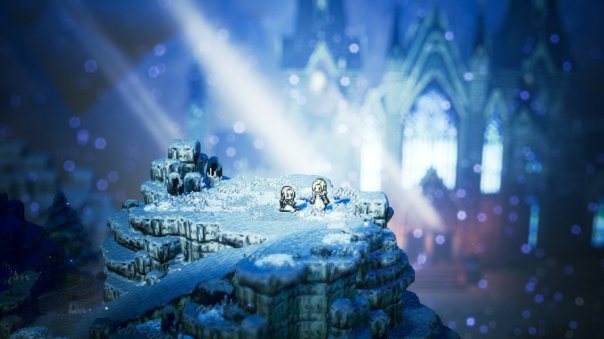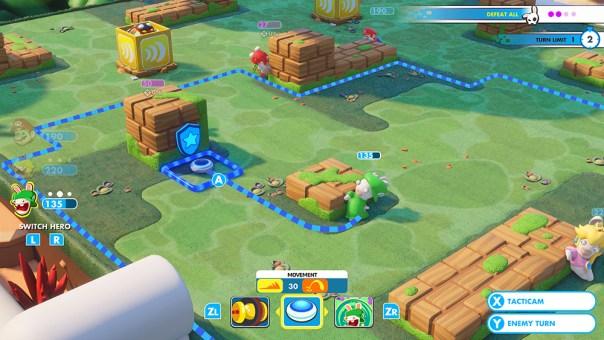I’ve sporadically gotten inspired to poke at Magical Burst, but I haven’t made a lot of progress until very recently. I posted about it a while back, but Magical Burst has two combat systems. “Skirmishes” are based on the combat rules from Magical Fury, a lightning-fast system that distills battles down to a handful of rolls and determining the consequences, while “full battles” are meant to be a tactical combat system that still generates consequences, but is also fun to play for its own sake. Shinobigami and some of Adventure Planning Service’s other recent games has a thing where there’s a “Climax Phase” to a game session where an all-out battle can happen, but otherwise clashes between characters end as soon as one character takes damage. It’s a little arbitrary perhaps, but particularly in the context of Shinobigami, it helps reinforce the genre. In the Persona games, although they use the same combat system, there’s a sharp distinction between fights with dungeon mobs and bosses. When fighting random shadows, your goal is to use their weaknesses to short-circuit things and end the battle as quickly as possible, whereas bosses are always more of an endurance test as you try to balance damage and healing. I really like having the flexibility to decide how much time you want to spend on combat in Magical Burst, because as much as I enjoy good tactical combat, I also sometimes want to just get on with the story.
Of course, that means that I’ve set myself the task of designing a tactical combat system, for the first time. Most of the RPGs I’ve designed have either minimized fighting or handled it with a more narrative approach, and while I have some really useful inspiration in D&D 4th Edition and Strike!, I needed more. I ended up looking to video games for inspiration. I went and bought a Nintendo Switch with Octopath Traveler and Mario + Rabbids Kingdom Battle.
Octopath Traveler is a recent game from Square Enix, a a 16-bit throwback reminiscent of Final Fantasy VI with modern touches, including a gorgeous “2D HD” look with sprite characters moving through a beautiful 3D world with sprite textures and extensive lighting effects.

OT has a turn-based combat system typical of old-school JRPGs, but each round, each of your characters gets a Boost Point (unless they spent BP the previous turn). You can spend these to increase the potency of the character’s actions, turning basic attacks into multi-attacks, making magic attacks more potent, making buffs last longer, and so on. Characters can store up to 6 BP and can spend up to 3 on an action, and there are a few special skills that can manipulate BP as well. (Enemies also have various vulnerabilities, and hitting them enough times with attacks they’re vulnerable to temporarily incapacitates them. This becomes a vital strategy in the game, and makes boosted basic attacks really useful beyond doing more damage.)
It’s a little bit different, but I hit on the idea of adding a currency called “Resonance” to full battles in Magical Burst. Magical girls start with 1 Resonance, and get one at the end of each round, plus (inspired by the Miss Tokens from Strike!) one when they miss with an attack. The different specializations also get bonus Resonance based on actions that relate to their roles in combat.
- I wanted to have an action economy similar to D&D4e and Strike!, but a little simpler, so I had it so that each character gets a Main Action and Support Action. Having movement be a Support Action tended to put a squeeze on the action economy though, and letting players spend a Resonance for an extra Support Action (or 3 Resonance for an extra Main Action) will hopefully alleviate that.
- With characters taking Overcharge points for both rolling too high with magical checks and for using certain Talents, there’s a significant risk of full battles generating too much Overcharge relative to other parts of the game. Letting players spend Resonance to power Talents and to negate Overcharge will allow them to manage both better when they want and take bigger risks when they feel it’s worth it.
I really hope this works out in playtesting, because it feels like a really fun mechanic that will hopefully shore up the full battle system in multiple ways.
Mario + Rabbids is turning out to be more or less exactly what I’d heard it was, which is to say XCOM Lite with Mario and Rabbids characters, which somehow results in a way better game than you’d think. Some of its core mechanics are deliberately cartoony–like how if you move one of your units into the position of one of your other units, they get catapulted to another location of your choice, letting them do a double move that ignores terrain obstacles–but it also does a good job of implementing tactics fundamentals like cover. It’s a bit weird that once you get past the prologue Mario promptly gets a gun (albeit a cartoony blaster thing) and winds up with mutant Peach and Luigi Rabbids as companions, but the game shows real skill in how it gradually introduces you to its mechanics, slowly increasing your palette of tactical considerations and options.

I’m still in the process of playing Mario + Rabbids and figuring out what to take from it, but I think the biggest take-away so far is how it makes such extensive use of terrain to create new tactical considerations. One of D&D4e’s shortcomings was that while terrain was (rightly) very important, the game needed better tools to create and use interesting terrain. As much fun as we had playing it, there were a few too many battles in mostly-empty rooms, regardless of whether or not the DM was using stuff out of modules.
Looking to video games for inspiration when designing tabletop RPGs is weird, because while video games are limited in how they can use human interaction, their mechanical aspects are much more varied, with sophistication in different places. I most likely wouldn’t have come up with something like Resonance if I’d only been looking at other RPGs for example. While in RPG design you do have to use and accommodate the conversation and the fiction, the medium has a long tradition of perhaps excessively falling back on (a certain vision of) realism.
I’ve also been working more on the youma rules, and one thing that’s been really helpful is Blog of Holding’s Monster Manual 3 on a Business Card. (There’s a 5th Edition version too by the way.) As good as D&D 4th Edition was in terms of tightly designed tactical combat, it took them until Monster Manual 3 to really nail down the math for monster stats. That’s especially true of solo monsters, which had too many hit points initially, making them a slog to fight. BoH distilled that improved math down until it could fit on one side of a business card, which lays bare the sheer simplicity of determining HP, damage, defense values, etc. once the designers figured out how to balance everything right. This is proving immensely helpful to me, especially since Magical Burst, following its source material, naturally tends towards solo monsters, which are significantly harder to design. While I think the ideas I’ve been working on (like having a “Spread” value that determines how good a youma is at fighting multiple enemies) are on the right track, I needed to see there in black and white that a solo monster outright has 4x the HP.
Sounds like fun, looking forward to when the next version drops.
I’m not sure I understand the resonance thematically, and mechanically it’s a bit on the heavy side considering battles are already not that fast. I would prefer tying it to an option, but it might be overly powerful even for a specialization. I may come around to it seeing it in play, though.
If you’re looking for tactical stuff in general, my homebrew/houserule Magical Burst replaced the combat map of five (iirc) zones in a line with combat maps of arbitrary shape (randomly rolled or based on the youma concept) and applying special terrain effects there, with effects more like wargames than anything else.
Example shapes:
• A flower/pentacle, one central zone with five zones connected to it. Originally for a crab spider themed Youma in the middle.
• An arena where four zones are all connected to the other three
• Moebius racetrack where all the zones are in a ring
• Chokepoint setup with two pairs of zones connected by one
• A small space, only two zones (not one, because you need two for ranged characters to not be at a disadvantage)
Within those maps, one or two zones get a special effect to start out with, as a result of youma powers, or due to powers used by magical girls.
Example effects:
• Innocent mortals, who will die if they take damage
• -2 penalty on rolls of one specific stat
• One damage per turn to MGs in the zone
• An trap that immobilizes the first MG to enter, needing sorcery or incredibly brute force to escape.
• A conditional wall, making the tile sometimes impassable in order to shape the map more
And an advanced specialization could do some of the following things:
• Reduce damage to magical girls in this zone if it comes from outside the zone (by 1, upgradeable to 3)
• Friendlies in the zone gain resolve equal to your Magic whenever they roll a 6
• Enemies in the zone take damage equal to your Magic whenever they roll a 6
• Any time OC is spent in the zone, pick: Either you and the one who spent it heal one resolve, or you both take +1 on the next roll.
I’m glad to see Magical Burst’s still on the mind! I’ve been using a mix of 5th with a sprinkling of 4th edition and homebrew for the past three years, and meandered my way here while doing some last-minute checks before running another one-shot night. I got some custom laser-cut tokens all ready to go.
So basically, keep it up! If a new version or an extra playtest is dropped, I’ll definitely be using it!
yesterday I played a Magical Burst 5.0 oneshot with four players, two who are new to pen&paper. In the end everyone was amazed about the system. There is so much freedom in describing the attacks. You can easily draw from the full anime potential. Since the rules are so minimalistic and fast paced everyone had much fun thinking about what new move they want to invent in a particular battle situation, it was great.
I build in two skirmish and one full battle against a big pumpkin monster (it was Halloween after all) and as the boss goes low on health I let them do a team finishing attack, wich was especially awesome and totally shredded the boss.
Perhaps the new Resonance system could back up team attacks and combos? And for the next game I definitly houserule a small flat +1 bonus based on the characters bounds (max two bonuses) for mundane actions, e.g. someone who loves cooking gain an additional +1 on her Real roll when trying to make food (Maybe I give an equal amount of disadvantages for balancing?).
However, thank you for your great work!
The Skirmish rules, with the single Spread for youma vs. collective Hits reminds me of Tunnels and Trolls combat system. PCs roll their various attacks into one total, measured against the Monster Rating of a monster or group of monsters; losing side takes the difference in damage (minus PC armor) which also reduced the MR for the next round. Not the same, but a similar collectiveness and simplicity. Fury/Burst5 girls have more formal options, T&T relies on descriptive cleverness for any complexity.